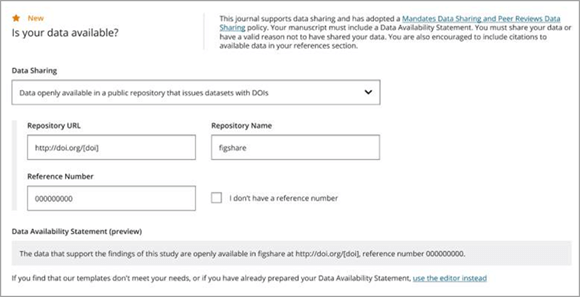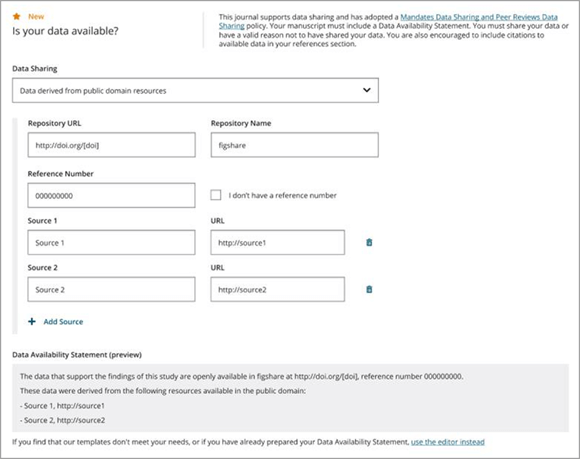Is your data available? (DAS)
The new Data Availability Statement (DAS) Generator brings all of the relevant information into Author Portal and helps authors generate an appropriate DAS by answering a few simple questions.
Journal Configuration
When this question is added to a journal configuration, answering the question is always required for the submitter. However, this does not mean that the submitter must always share their data.
Configure the question according to the journal's requirements regarding data availability:
- If the journal encourages, but does not require, that authors provide a data availability statement, select Encourages Data Sharing.
- If the journal requires that authors provide a data availability statement, select Expects Data Sharing.
- If the journal requires that authors share their data, select Mandates Data Sharing.
- If the journal requires that authors share their data and that the data be peer reviewed, select Mandates Data Sharing and Peer Reviews Data.

Submitter View
When any of the four configuration options mentioned above are selected, the question will be displayed as follows for the submitter during the Additional Information submission step in Author Portal:

- Select one of the built-in templates from the dropdown list. Depending on the submitter's selection, a corresponding form will be displayed. The questions on the form guide the submitter to provide the required information. For example, if they select Data openly available in a public repository that issues datasets with DOIs from the dropdown, they must then provide the repository name and URL, and, if available, a reference number.
- Click use the editor instead. With this option, the submitter can enter the data availability statement as text.
The built-in templates will cover the most common scenarios, but there are some complex data sharing scenarios that cannot be covered by the templates. For example, multiple data sets with different availability. In cases like this, the author can use the editor instead to switch to a free-text entry for their more complex DAS.
The free-text editor is also useful in cases where the author has already written a DAS and included it in their manuscript. Instead of completing the forms, they can click use the editor instead and enter their existing DAS.
When using the template option, the submitter must select one of the following templates from the dropdown list. Some templates are not displayed when the question has been configured as Mandates Data Sharing or Mandates Data Sharing and Peer Reviews Data. These cases are noted below.
Data openly available in a public repository that issues datasets with DOIsData openly available in a public repository that does not issue DOIsData derived from public domain resourcesEmbargo on data due to commercial restrictionsData available on request due to privacy/ethical restrictionsData subject to third party restrictionsData available on request from the authorsNote: This template is not available when the question has been configured as Mandates Data Sharing or Mandates Data Sharing and Peer Reviews Data.Data sharing not applicable – no new data generatedData sharing not applicable – no new data generated, or the article describes entirely theoretical researchAuthor elects to not share dataNote: This template is not available when the question has been configured as Mandates Data Sharing or Mandates Data Sharing and Peer Reviews Data.Data available in article supplementary material
Once the author selects an option from the dropdown, an appropriate form will be displayed. Consider the following examples:
The submitter has selected the Data openly available in a public repository
that issues datasets with DOIs template:

The submitter has selected the Data derived from public domain resources
template:

As the author completes the form fields, the data availability statement, a preview of which is displayed in the grey box, will be updated to reflect the information provided by the submitter. The resulting statement will be sent to S1M as the DAS.
ScholarOne Custom Question Detail Group Configuration
| Detail Group Name | Data Availability Statement |
|---|---|
| Response External ID(s) |
|